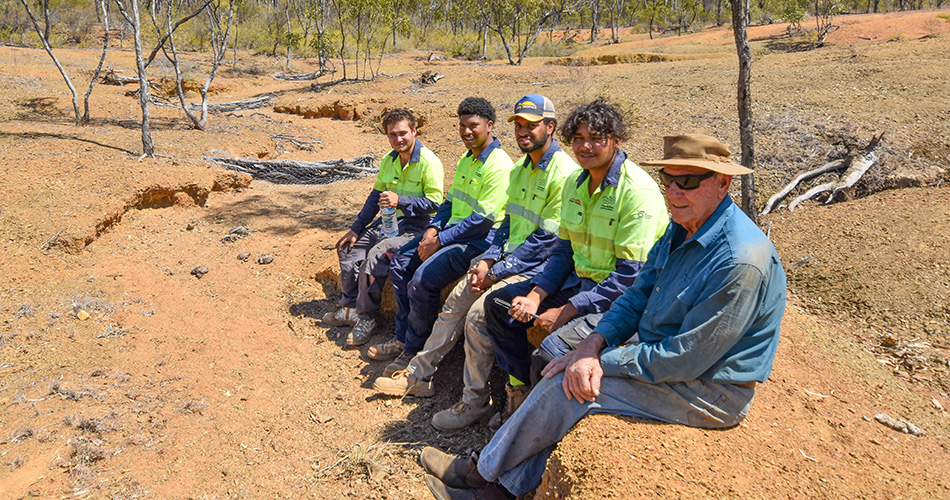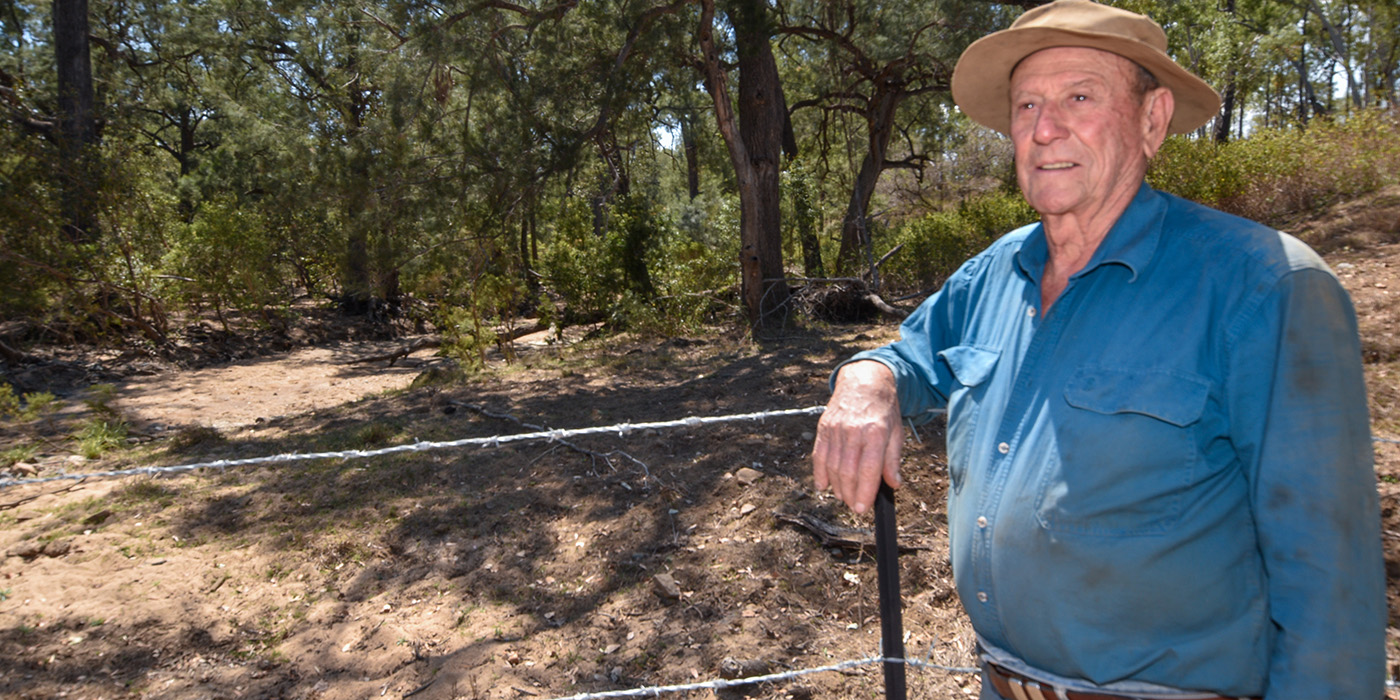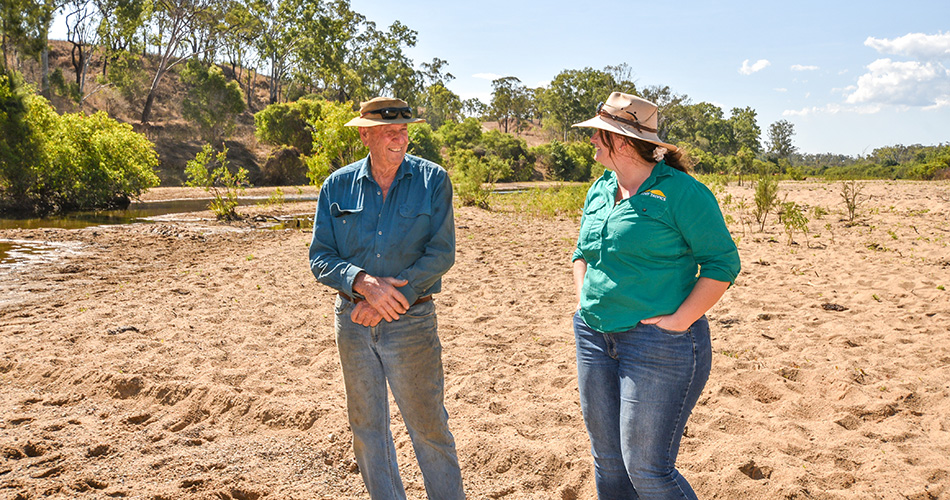Upper Burdekin graziers manage for dry seasons and drought
Kangaroo Hills grazier Dino Penna with the new fence that will keep cattle out of the creeks.
Running a profitable business while ensuring sufficient end of dry season ground cover has been at the core of Dino and Norma Penna’s grazing enterprise since moving to Kangaroo Hills, south west of Ingham, in 1998.
With two creeks — 4 Mile and Douglas — running through the 62,900ha property, and Douglas Creek flowing the length of the property and into the Burdekin River, managing stock on riparian areas has been a focus.
“Fencing and water infrastructure are key to improving grazing management and land condition, and our overall grazing business operation revolves around getting these right,” Dino said.
“Riparian fences control stock access to the creeks, particularly during dry seasons.
“Water infrastructure in off-stream areas encourages evenly spread grazing throughout a paddock.
“We’ve increased the number of dams from 30 to 84, over the years. Making improvements takes time and can be costly, and progress can be hampered by drought years.”
This is why the Pennas were keen to sign up to The Herding Change Through Grassroots Recovery project — to obtain support to install fencing to split a 2,680ha paddock to enable grazing rotation to increase rest periods for pasture and encourage recovery of perennial, productive and palatable (3P) grasses.
The fencing project excludes cattle from one side of 4 Mile Creek, a watercourse with steep banks making access to many areas of the paddock more difficult, resulting in cattle preferentially grazing the flatter areas.
The smaller paddock will be used short-term to house weaners, and spelled between mobs, and during the wet season. The larger paddock will be home to cows and calves for several months before wet-season spelling.
Independent of the project, the Pennas constructed a dam in the larger of the two new paddocks to ensure grazing pressure would be evenly spread. Dino will also monitor the paddocks after the new grazing system starts.
A meticulous record keeper, Dino has painstakingly kept records since moving to the property 25 years ago, from grazing records, pasture availability, rainfall, and everything in between.
“Records are important. How can you manage if you’re not monitoring? We need to monitor how cattle are faring, how the grass is faring, what’s happening with the season, and how water allocation is faring,” Dino said.
“We’re managing for the dry times. Projects like this one are all part of a bigger plan to look after our land.
“You have to. There’s no point having it if you’re not continuously working on it and learning from past actions.”
He said he was optimistic the project would result in increased ground cover within two wet seasons, resulting in improved water infiltration and regermination of plant species.
“Through planned grazing and rest, I’m hoping grasses and forage will come back which means over time yield will improve,” Dino said.
“This’ll allow us to have more control of the timing and intensity of grazes, and potentially, supplement feeding may be reduced.”
Dino and Norma have submitted a second project plan which involves constructing 13km of riparian fencing along Douglas Creek. This would fulfill the Penna’s long-term plan to fully fence off this creek.
Kangaroo Hills is one of more than 60 properties in the Upper and East Burdekin sub-catchments participating in the project, adopting grazing land management actions to improve land condition, productivity and water quality. Collectively, these properties are delivering a reduction in end-of-catchment load of 49kt of fine sediment each year.
The Herding Change Through Grassroots Recovery project is funded through the partnership between the Australian Government’s Reef Trust and the Great Barrier Reef Foundation.
Kangaroo Hills grazier Dino Penna and NQ Dry Tropics Grazing Field Officer Ashleigh Kilgannon inspect the new infrastructure.
Great chance to tackle troublesome erosion

Dino Penna jumped at the opportunity to work with NQ Dry Tropics’ Healing Country team to help tackle a troublesome erosion hotspot.
The team uses non-mechanical methods where fragile soils mean machines aren’t the best option.
At Kangaroo Hills, leaky weirs (porous check dams) were installed. These are ‘natural’ eco-structures designed to slow water and sediment moving down a slope, and spread over floodplain alluvial areas, to allow more of the sediment to drop out instead of being carried all the way down to a creek or river.
They’re built from natural materials such as rocks, logs, sticks and vegetation, sourced from the immediate surrounds on-property, making them a cost effective tool for landholders to combat erosion.
Keeping water in the landscape improves infiltration which leads to improved pastures, improving groundcover.
Dino said he was keen to see how the weirs hold up in the coming wet season. He said the works complemented other activities being carried out across the property to ensure sufficient end of dry season ground cover.
The Healing Country project enables young First Nations people to connect with Country while helping to improve land condition and reduce sediment run-off. The project encourages Traditional Owner groups and regional stakeholders to work together to build capacity, deliver natural resource management outcomes and improve access to Country.
The project is funded through the Queensland Government’s Reef Assist program under the Queensland Reef Water Quality Program.


